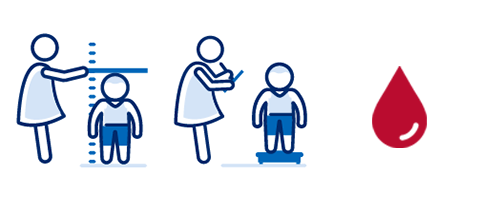New Resources Provide Updated Guidance on Biomarker Collection in DHS-8

The DHS Program is pleased to announce the availability of the Biomarker Manual: Training Program for Measuring and Testing for Biomarkers and the DHS Height Standardization Tool on The DHS Program website.
The Biomarker Manual aligns with DHS-8 standard materials and policies representing the most up-to-date procedures. Standard measures in DHS surveys include height/length, weight, and hemoglobin. Anthropometric data are collected for children age 0-59 months, women age 15-49, and men age 15-49, 15-54, or 15-59 depending on the survey. These data are used to estimate malnutrition in children, body mass index (BMI) in adults, and BMI-for-age in adolescents. Hemoglobin measurement provides anemia prevalence estimates for children age 6-59 months along with women and men.
| Measurements from | Biomarkers collected | Indicators reported |
|---|---|---|
Children age 0-59 months Children age 6-59 months | Height/length Weight  Hemoglobin  | -Malnutrition in children -Anemia prevalence |
Women age 15-49 Men age 15-49, 15-54, or 15-59  | Height Weight  Hemoglobin  | -BMI in adults -BMI-for-age in adolescents (age 15-19) -Anemia prevalence |
The Biomarker Manual is a critical resource used by DHS Program biomarker specialists and consultants to train biomarker technicians and supervisors on all aspects of collecting high-quality biomarker data. The Biomarker Manual can serve as a tool for others conducting surveys similar to DHS surveys. The manual includes procedures for:
- Completing The DHS Program Biomarker Questionnaire and related documentation
- Anthropometric measurement
- Capillary blood collection
- Hemoglobin measurement
- Biohazardous waste management and disposal
The Biomarker Manual also includes examples of materials to aid in data collection – informational pamphlets provided to households, referral forms provided for cases of severe acute malnutrition and severe anemia, forms used during training on anthropometry (e.g., standardization exercises), and forms for monitoring equipment during fieldwork (daily maintenance logs).

The DHS Height Standardization Tool is used during the anthropometry standardization exercise to record trainees’ height or length measurements and to calculate trainees’ accuracy and precision. The results of the calculations are illustrated visually for each trainee and compared to the pass/fail cutoffs for accuracy and precision. The tool is a useful resource for anyone collecting anthropometry data in surveys or research as it helps to identify trainees who may need further training and re-standardization before data collection.
Many DHS surveys collect additional biomarkers in addition to the standard biomarkers mentioned above, e.g., malaria rapid diagnostic testing (RDT), dried blood spot (DBS) preparation for lab-based testing for a variety of infections or conditions, blood pressure measurement, and micronutrient biomarkers. The resources in the new Biomarker Manual can be adapted to accommodate the collection of these other biomarkers.


